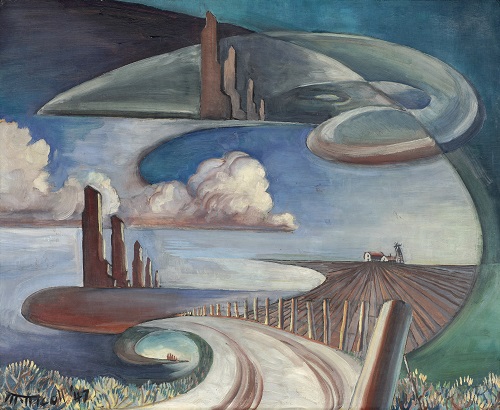(1909-1985)
Currently not on display

Utopia, 1947
Oil on board
16″ x 19″
Gift of Dr. Morris C. Shumiatcher, O.C., S.O.M., Q.C. and Dr. Jacqui Clay Shumiatcher, S.O.M., C.M., 2017; sc.2017.77
Marion Nicoll (1909-1985) stands as an impactful figure in the history of Canadian feminist art and craft, and modernism and abstraction in Alberta. She was the first female instructor at the Provincial Institute of Technology and Art (now the Alberta College of Art and Design) in Calgary, a rarity in Canada at the time. Nicoll’s summer at Saskatchewan’s Emma Lake Artist Workshop in 1957 with American artist Will Barnet was a pivotal experience. She described it as a “…hard, driving course. I mean, there was something electric.… The whole place just quivered.… And I just took off!”(1). This was a period of radical change for Nicoll as she discovered abstraction. Many other Canadian artists were introduced to ideas around abstract painting through the Emma Lake workshops, opening up a world of expression beyond representational painting and transforming the arts in Canada in the process. However, Utopia (1947) was painted ten years prior, during a period in which Nicoll favoured realism, but was already immersed in curvilinear abstract drawing.
The change in the direction of Nicoll’s artwork was also influenced by another artist, Painters Eleven member Jock Macdonald, a colleague at the Provincial Institute of Technology and Art. In 1945, he had encouraged her to try automatic drawing, a process by which the hand moves randomly across the paper with the aim of translating the subconscious into line, without the interference of thought (2). Of this creative exercise, Nicoll remarked, “It’s almost as though the pencil were pulling me”(3). This influence can be directly traced to Grace Pailthorpe, a British surrealist painter and psychoanalyst. Macdonald had been introduced to automatic drawing by Pailthorpe, who became an influential figure in 1940s Canada. Evidence of the Surrealist imagination also appears in Utopia’s experimental and dreamlike landscape.
The small picture plane belies a grand vision of an alternative prairie world. Perhaps inspired by a sense of postwar optimism, Nicoll’s imposing grain elevators rise from cloud-like forms to echo characteristics of urban architecture. These skyscraper elevators combine both regionalist and city architecture to inhabit a new, fantastical world in and above the southern Albertan landscape. Interestingly, Nicoll’s paternal grandparents established a sandstone quarry in the late 1880s after emigrating to Fort Calgary from Scotland. Many historic downtown buildings in Calgary today were built using stone from the family’s quarry, making an enduring contribution to the development of a new city rising from the prairie. Nicoll also vividly remembered visiting her maternal grandparents’ farm in Evarts as a child. A diminutive homestead appears in Utopia’s distance.
The scene depicts more sky than land, with areas where the two are both blurred and as one. Nicoll frees the flat horizon line from gravity, curving and bending it so it appears to float, taking on the shape of waves. The clean and fluid lines here may hint at Nicoll’s future abstract forms. Rolling and furrowed fields, the swirling sky and directional fence-posts in the right-hand foreground appear in other work such as Chinook (1945, tempera on board). Indeed, the skyborne shapes may reference warm chinook winds, the phenomenal forces of sudden change, and a popular theme for Nicoll. The subject matter of this early work, ostensibly the prairies, their agriculture and her surroundings, appear throughout her oeuvre, including later abstract work. Utopia clearly demonstrates that, despite her love for travel and big cities, Nicoll was deeply connected to and saw rich potential in the Albertan landscape.
- Quoted in Ann Davis; Elizabeth Herbert; Jennifer E Salahub; Christine Sowiak, Marion Nicoll: Silence and Alchemy (Calgary: University of Calgary Press, 2014) 1.
- Examples of this technique in the University of Regina President’s Art Collection can be seen in Robert Motherwell’s Africa suite
- Quoted in Ann Davis; Elizabeth Herbert; Jennifer E Salahub; Christine Sowiak, Marion Nicoll: Silence and Alchemy (Calgary: University of Calgary Press, 2014) 7.
Bibliography
Davis, Ann; Herbert, Elizabeth; Salahub, Jennifer E ; Sowiak, Christine, Marion Nicoll: Silence and Alchemy. Calgary: University of Calgary Press, 2014
Pashak, Natasha, Almost Outnumbered: The role of Alberta in the life and work of Marion Nicoll. Concordia University (Canada), ProQuest Dissertations Publishing, 2010. MR67239.


